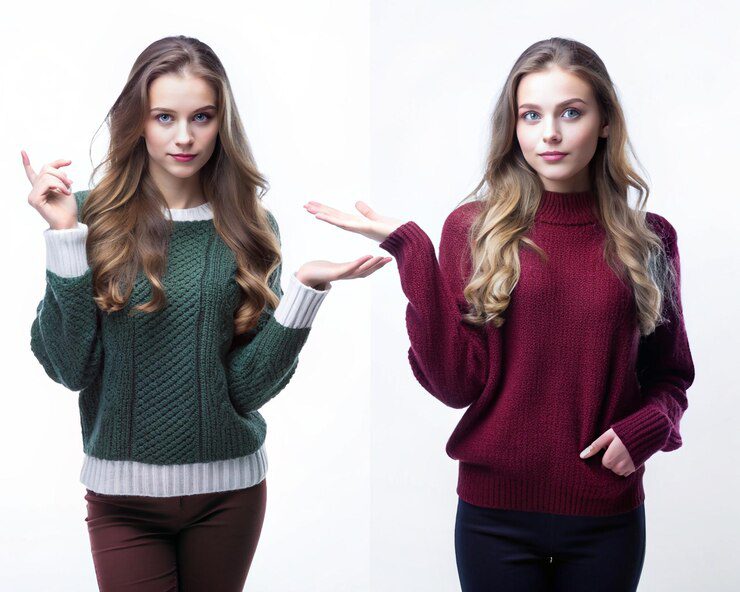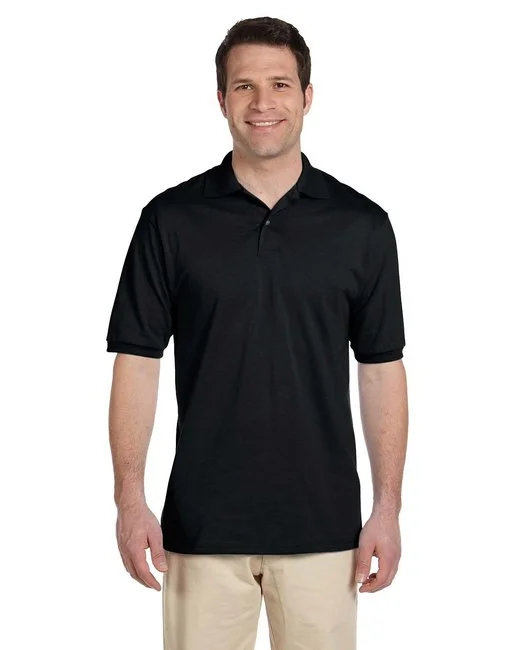What is the difference between a sweater and a sweatshirt?

When it comes to casual and cozy clothing, sweaters and sweatshirts are two popular choices. While both are designed to keep you warm and comfortable, they serve different purposes, and their fabric composition, styles, and even cultural associations can differ significantly. In this article, we’ll explore the key differences between a sweater and a sweatshirt to help you understand which one best suits your needs.
Definition and purpose
Sweater
A sweater is a knitted garment designed to keep the wearer warm. Traditionally, sweaters were made of wool, but modern sweaters can be crafted from various materials like cotton, cashmere, polyester, and blends. Sweaters come in a variety of styles and are often seen as more formal or semi-formal attire, though they can also be worn casually. Sweaters can be cardigans, turtlenecks, pullovers, or V-necks, depending on the design and occasion.
Sweatshirt
A sweatshirt, on the other hand, is generally more casual and is made from heavier fabrics such as cotton, fleece, or a cotton-polyester blend. Sweatshirts are designed primarily for comfort and are frequently associated with sportswear or loungewear. Originally created as athletic wear, sweatshirts are now widely worn as casual clothing, often with a relaxed, loose fit. They may come with or without hoods, commonly referred to as “hoodies” when the hood is present.
Fabric and construction
Sweater fabric
Sweaters are typically made from knitted materials. The most traditional material is wool, which is known for its insulating properties and moisture-wicking abilities. However, sweaters can also be made from cotton, acrylic, cashmere, and other synthetic or natural fibers. The knitting techniques used in sweaters create a textured look and add to their formal or semi-formal appearance. Wool sweaters are perfect for colder weather, whereas lighter cotton or synthetic sweaters can be worn year-round.
Characteristics of sweater fabrics:
- Wool: Great insulation and warmth; retains heat even when wet.
- Cashmere: Soft, luxurious, and highly insulating.
- Cotton: Breathable and lightweight; ideal for mild weather.
- Acrylic: A cheaper alternative to wool; warm and lightweight but less breathable.
Sweatshirt fabric
Sweatshirts are generally made from cotton, polyester, or a cotton-polyester blend. One of the key features of a sweatshirt is the fleece lining, which provides warmth and comfort. Unlike sweaters, which are knitted, sweatshirts are constructed from woven materials. The fabric is often treated to enhance moisture-wicking capabilities, making sweatshirts ideal for athletic activities. The fleece inside a sweatshirt adds to its insulating properties, though the exterior can range from smooth to slightly textured.
Characteristics of sweatshirt fabrics:
- Cotton: Soft, breathable, and comfortable for everyday wear.
- Polyester: Durable, moisture-wicking, and resistant to shrinking.
- Cotton-Polyester Blend: Combines the breathability of cotton with the durability of polyester.
- Fleece Lining: Adds extra warmth, making sweatshirts ideal for colder climates.
Style and versatility
Sweater style
Sweaters come in various styles that can suit different occasions. Some of the most popular sweater styles include:
- Pullover: A basic sweater that you pull over your head; versatile and can be worn casually or formally.
- Cardigan: A front-open sweater that can be buttoned or zipped; great for layering.
- Turtleneck: A high-neck sweater that provides extra warmth.
- V-neck: A sweater with a V-shaped neckline, often considered more formal.
Sweaters are generally more versatile in terms of where and when they can be worn. They can be dressed up with a collared shirt or paired with jeans for a more casual look.
Sweatshirt style
Sweatshirts are typically more casual in appearance and come in fewer styles compared to sweaters. The most common variations include:
- Crewneck: A sweatshirt with a round, collarless neckline.
- Hoodie: A sweatshirt with a hood, often featuring drawstrings and a front pocket.
- Zip-Up: A hoodie with a full or partial zipper on the front.
Sweatshirts are best suited for casual occasions and are often associated with athleisure. They pair well with sweatpants, jeans, or leggings, making them a go-to option for lounging, exercising, or running errands.
Warmth and comfort
Sweater warmth
Sweaters, especially those made from wool or cashmere, provide excellent insulation and warmth. Wool, in particular, retains heat even when wet, making it ideal for cold and damp environments. Sweaters are often used for layering during colder months and are a staple of fall and winter wardrobes.
However, not all sweaters are equally warm. Lightweight cotton sweaters are breathable and ideal for transitional weather, while heavier wool or cashmere options are better suited for extreme cold.
Sweatshirt warmth
Sweatshirts, especially those lined with fleece, also provide warmth, but they are generally not as insulating as wool sweaters. Sweatshirts are designed more for comfort than extreme cold, making them a better option for mild to moderately cool temperatures.
The fleece lining in sweatshirts traps heat close to the body, making them a cozy option for lounging at home or casual outdoor activities.
Occasions and usage
When to wear a sweater
Sweaters are versatile and can be worn for a variety of occasions, ranging from formal events to casual outings. A wool or cashmere sweater paired with slacks can create a polished look suitable for the office or even a semi-formal event. Lighter sweaters, such as those made from cotton or acrylic, are perfect for casual weekend wear or transitional weather. Depending on the design, sweaters can be worn for both work and play, making them a wardrobe staple.
When to wear a sweatshirt
Sweatshirts are more casual and are typically worn for relaxed settings such as lounging at home, running errands, or working out. Hoodies, in particular, are popular for their relaxed fit and casual vibe. Due to their association with sportswear, sweatshirts are often worn during physical activities or as part of an athleisure outfit. They can also be worn during outdoor activities like hiking, as their soft, insulating fabric provides comfort in cooler temperatures.
Maintenance and durability
Sweater maintenance
Sweaters, especially those made from wool or cashmere, require special care. Most sweaters should be hand-washed or dry-cleaned to maintain their shape and softness. Wool sweaters can shrink if exposed to high heat, and cashmere is prone to pilling. Using a sweater comb or a fabric shaver can help remove pilling. Cotton sweaters are generally easier to care for, as they can be machine-washed, though they should still be dried on low heat to prevent shrinkage.
Sweatshirt maintenance
Sweatshirts are generally low-maintenance. Most cotton or polyester sweatshirts can be machine-washed and tumble-dried without any issues. The only precaution you may need to take is turning the sweatshirt inside out to prevent any logos or designs from fading. Sweatshirts made with higher-quality fleece may require a bit more care, as frequent washing can cause the fleece to lose its softness over time.
Cultural associations
Sweater culture
Sweaters are often associated with formality and sophistication, especially in certain styles like the turtleneck or cardigan. They are a staple of winter fashion in many parts of the world and are often layered over collared shirts for a more polished appearance. Wool and cashmere sweaters, in particular, are seen as luxury items due to their high-quality materials and craftsmanship.
Sweatshirt culture
Sweatshirts, especially hoodies, are more closely associated with streetwear, sports, and casual fashion. Hoodies have also become a symbol of youth culture and rebellion, often worn as part of a more relaxed, “grunge” style. Despite their casual roots, sweatshirts have also become part of the athleisure trend, blending fashion and function for a stylish yet comfortable look.

Q&A Section
Are sweaters or sweatshirts warmer?
Sweaters made from wool or cashmere are generally warmer than sweatshirts, especially in colder climates. Wool retains heat even when wet, making it ideal for cold, damp conditions. Sweatshirts with fleece lining provide warmth but are not as insulating as wool or cashmere. Sweatshirts are more suited for casual wear and moderate temperatures, while sweaters are perfect for layering in colder weather.
Can sweatshirts be worn in formal settings?
Sweatshirts are typically considered too casual for formal settings. However, in recent years, the rise of athleisure has blurred the lines between casual and formal attire. While you can dress up a sweatshirt by pairing it with more structured pieces, such as tailored trousers, it’s still best suited for informal occasions like running errands, lounging, or exercising.
Do sweaters stretch out over time?
Sweaters, particularly those made from natural fibers like wool and cotton, can stretch out over time, especially if not cared for properly. To maintain their shape, it’s important to store them folded rather than hung, as hanging can cause them to stretch. Hand washing or dry cleaning delicate sweaters and avoiding high heat when drying can also help preserve their original shape.
What is the best material for a warm sweater?
Wool is considered one of the best materials for a warm sweater, as it provides excellent insulation and retains heat even when wet. Cashmere is another top choice for warmth and softness, though it tends to be more expensive. If you’re looking for a budget-friendly option, acrylic can mimic the warmth of wool while being more affordable.
Can you layer a sweatshirt?
Yes, sweatshirts can be layered, particularly with jackets or coats for added warmth. However, because sweatshirts are bulkier than sweaters, layering may create a more casual look. They are often layered under windbreakers or worn over t-shirts for a relaxed, sporty vibe. For colder days, sweatshirts can be paired with a heavier coat for both warmth and style.
Share:


Produto ejemplo 2 copy
$11.77Most Popular
How to Choose the Perfect Outfit for the First Day of School
Introduction to Preppy Style for School
Introduction to Sneaker Balls: Style and Comfort in One Event
Related Posts
Dinner Outfit Ideas: How to Find the Perfect Balance Between Elegance and Comfort
When it comes to choosing an outfit for a dinner, the challenge is in achieving the balance between elegance and
How to Choose the Perfect Outfit for the First Day of School
The first day of school not only marks the beginning of a new academic cycle, but also an opportunity to
Introduction to Preppy Style for School
Preppy style is a classic in school fashion that has endured over the years. Its origins lie in the private
Introduction to Sneaker Balls: Style and Comfort in One Event
Sneaker balls are taking the fashion world by storm, redefining what it means to dress for an event with class.

